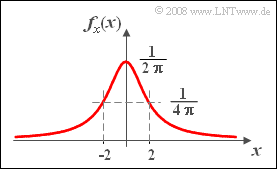Difference between revisions of "Aufgaben:Exercise 3.12: Cauchy Distribution"
From LNTwww
| Line 25: | Line 25: | ||
<quiz display=simple> | <quiz display=simple> | ||
| − | {What is the distribution function $F_x(r)$? What is the probability that $x$ is smaller than $2$ by a small | + | {What is the distribution function $F_x(r)$? What is the probability that $x$ is smaller than $2$ by a small magnitude? |
|type="{}"} | |type="{}"} | ||
${\rm Pr} (|x| < 2) \ = \ $ { 50 3% } $ \ \%$ | ${\rm Pr} (|x| < 2) \ = \ $ { 50 3% } $ \ \%$ | ||
| − | {What is the probability that $x$ is greater in | + | {What is the probability that $x$ is greater in magnitude than $4$? |
|type="{}"} | |type="{}"} | ||
${\rm Pr} (|x| > 4) \ = \ $ { 29.6 3% } $ \ \%$ | ${\rm Pr} (|x| > 4) \ = \ $ { 29.6 3% } $ \ \%$ | ||
Revision as of 10:02, 13 January 2022
The probability density function of the Cauchy distribution is given as follows:
- $$f_x(x)=\frac{\rm 1}{\rm 2 \pi}\cdot \frac{\rm 1}{\rm 1+ (\it x/\rm 2)^{\rm 2}}.$$
From the graph you can already see the extremely slow decay of the PDF course.
Hints:
- The exercise belongs to the chapter Further Distributions.
- In particular, reference is made to the page Cauchy PDF .
Questions
Solution
(1) Comparing the given PDF with the general equation in the theory part, we see that the parameter $\lambda= 2$ is.
- From this follows (after integration over the PDF):
- $$F_x ( r ) =\frac{1}{2} + \frac{\rm 1}{\rm \pi}\cdot \rm arctan(\it r/\rm 2).$$
- In particular.
- $$F_x ( r = +2 ) =\frac{1}{2} + \frac{\rm 1}{\rm \pi}\cdot \rm arctan(1)=\frac{1}{2} + \frac{\rm 1}{\rm \pi} \cdot \frac{\rm \pi}{4 }=0.75,$$
- $$F_x ( r = -2 ) =\frac{1}{2} + \frac{\rm 1}{\rm \pi}\cdot \rm arctan(-1)=\frac{1}{2} - \frac{\rm 1}{\rm \pi} \cdot \frac{\rm \pi}{4 }=0.25.$$
- The probability we are looking for is given by the difference of.
- $${\rm Pr} (|x| < 2) = 0.75 - 0.25 \hspace{0.15cm}\underline{=50\%}.$$
(2) According to the result of the subtask (1) is $F_x ( r = 4 ) = 0.5 + 1/\pi = 0.852$.
- Thus, for the "complementary" probability ${\rm Pr} (x > 4)= 0.148$.
- For symmetry reasons, the probability we are looking for is twice as large:
- $${\rm Pr} (|x| >4) \hspace{0.15cm}\underline{ = 29.6\%}.$$
(3) All proposed solutions are true:
- For the variance of the Cauchy distribution holds namely:
- $$\sigma_x^{\rm 2}=\frac{1}{2\pi}\int_{-\infty}^{+\infty} \hspace{-0.15cm} \frac{\it x^{\rm 2}}{\rm 1+(\it x/\rm 2)^{\rm 2}} \,\,{\rm d}x.$$
- For große $x$ the integrand yields the constant value $4$. Therefore the integral diverges.
- With $\sigma_x \to \infty$ however, even Chebyshev's inequality does not provide an evaluable bound.
- "Natural" random variables (physically interpretable) can never be cauchy distributed, otherwise they would have to have infinite power.
- On the other hand, an "artificial" (or mathematical) random variable (example: the quotient of two zero mean quantities) is not subject to this restriction.
